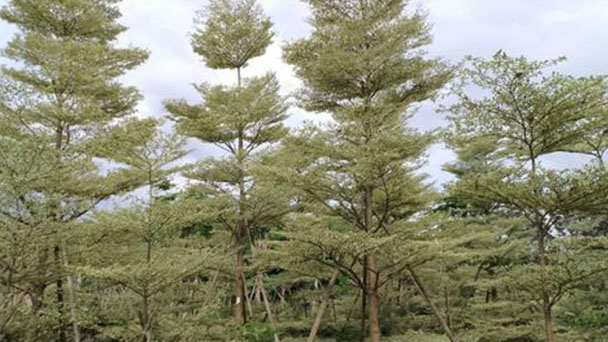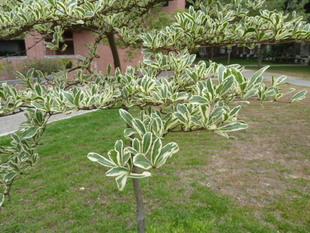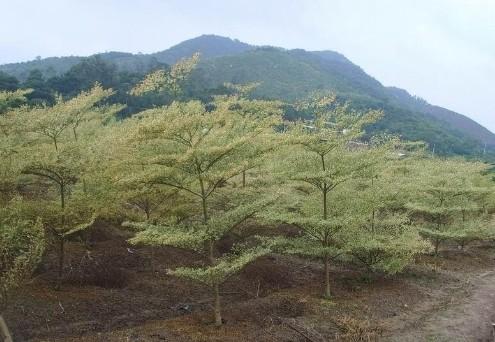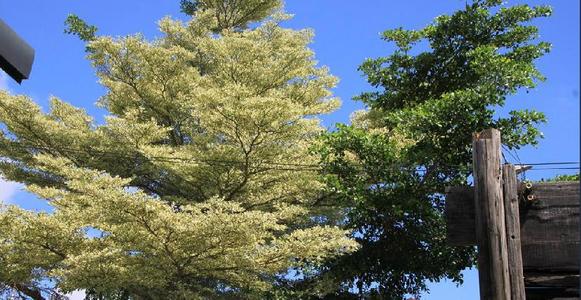Terminalia Mantaly Tree Profile: Info & Care Guide
Written by Maggie
Nov 03 2021

Terminalia Mantaly, also called Madagascar almond, originated in Madagascar Island in the Indian Ocean of East Africa. Terminalia Mantaly is a tall tree with soft stems, strong roots, strong wind resistance and salt tolerance, making it an excellent coastal tree.
Terminalia Mantaly Picture

Terminalia Mantaly Tree Characteristics
| Botanical Name | Terminalia mantaly |
| Common Names | Madagascar almond |
| Plant Type | Trees, Shrubs |
| Light | Sun growing, Semi shade |
| Native Areas | Africa - Madagascar |
| Mature Size | 6 to 8 meters high, 2 to 4 meters wide |
| Water | Normal, Can tolerate more |
| Foliage color | Variegated, Green, Cream or off white |
Terminalia plant (Madagascar almond) is a dicotyledonous plant in angiosperms. Terminalia Mantaly is a deciduous large tree with a height of up to 20 m. The main stem is upright, round and straight, and the crown can reach 8 m. Bark is light brown, scattered with light colored punctate short lines, 0. 5~1. 0 cm long, 1~2 mm wide, little sharpness; Branches of terminalia mantaly are short and natural stratification, round in the trunk around, vigorous upward, orderly hierarchy, all around the upward expansion, was inclined bucket-shaped, branches soft and fine, strong anti-typhoon ability; Leaves are oblast-lanceolate or oblast-obovate, 3~5 cm long, 1~3 cm wide, with 4~6 pairs of pinnate veins, 4~7 impellate. The outer margin of the leaf is light golden yellow, accounting for about 1/2 of the leaf surface, and the center of the leaf is light green, so it is called silver edge olive kernel. Terminalia Mantaly is heat-resistant, drought-resistant, wind-resistant, barren, pollution resistant, highly adaptable, any soil can be planted, and grows rapidly in well-drained, sunny loam soil. Every year, bright red leaves start to germinate in spring, and the leaves extend at the end of spring, with a length of 1 to 2 cm and a width of 1 cm. In spring, the leaves of Terminalia Mantaly gradually mature, the color of the leaves becomes light golden yellow, and then the tree presents snow-white, so it is also known as snowflake olive kernel; From summer to autumn, with the arrival of the growing season, a large number of new shoots sprouted and mixed with little red leaves in a silvery white to show the color change of Terminalia Mantaly. In autumn, the red leaves retreat and the light golden yellow turns to gold. After summer, winter begins to come, and the old leaves gradually fall off, but the colorful leaves growing in summer are still there, and the ornamental value still remains. Only in spring of the next year did the leaves fall off and enter a short dormancy. The leafless branches of Terminalia Mantaly still extend upward after falling leaves, showing the unique style of Terminalia Mantaly. Due to the slow growth of the tree species, the diameter at breast diameter of 5 years is only 4~6 cm, the height of the tree is 4~5 m.
Terminalia Mantaly Tree Native Habits
Terminalia plant (Madagascar almond) is fond of light and warm and humid climates. It requires annual rainfall of 1 800~2 000 mm and relative humidity of 70% ~80%. Terminalia Mantaly has the best growth on the deep and moist, fertile and loose soil layer, and the slightly acidic sandy soil. Growth in hot and humid climate conditions, full light or moderate shade are good growth, slightly barren, in coastal sand, peat soil, Carboniferous rock soil can grow, can be resistant to light frost and short-term low temperature.

Terminalia Mantaly Pest Control
Terminalia Mantaly (Madagascar almond) pests and diseases are mainly moths, moths like to eat young leaves, resulting in the tree's weak growth, and even death. Red fire ant root damage is also common in southern China.
- Moth control: spray leaf surface with 800 times chrysanthemum fat.
- Pest control: root irrigation with phoxim solution.
Terminalia Mantaly Tree Care
- Best time for Terminalia mantaly tree propagation: sowing is suitable for spring to summer;Grafting in early March is appropriate. In rainy weather, it is not suitable for grafting.
- Terminalia Mantaly best growth soil: terminalia mantaly are sterile, saline-tolerant, highly adaptable, and can be grown in any soil, but fertile sandy soil is preferred.
- Growth humidity requirement: terminalia mantaly prefers high temperature and humidity, and the relative humidity in the Mediterranean region is generally 40 {bf} -65 {bf}.
- Best growth temperature: Terminalia Mantaly likes high temperature and heat, the suitable growth temperature is about 23-32℃, and the top branches below 0℃ are vulnerable to freezing damage.
- Best growth of light: Terminalia Mantaly positive plant, sufficient sunlight.
- Water and light: Good drainage and sunshine should be required. Young Terminalia Mantaly needs more water and should be replenished frequently. Apply organic fertilizer in spring and summer every year. If the crown is not balanced, after the winter leaves, slightly trim.
Terminalia Mantaly Pruning
Cut off the lower branches of the trunk, which can be very long. Do not clip to the terminal bud and lateral bud, so that you can prune Terminalia Mantaly's side branches and leaves after the expansion. The terminal stem can be unlimited growth, so pay more attention to the side branches. The closer to the base of the branch, the less pruning! In other words, The longer the branch is closer to the base, the shorter the branch closer to the top.For terminalia mantaly tree umbrella pruning, you must first focus on the first and second side branches and then cut off the top shoot trunk from the second and third side branches. Nutrition will be provided to the first and second side branches in the future, and the canopy will become open, and people will be dangling in a natural umbrella under the tree.
Terminalia Mantaly Uses
Terminalia plant (Madagascar almond) unique style, tall and straight branches, often used as a garden tree, street tree. Tall in shape, the trunk of Terminalia Mantaly is round and straight, but the branches are very soft, and the root group grows firmly and is extremely resistant to strong winds and salt, making it an excellent coastal tree species.

Latest Updated
- Benefits of Bugleweed - 7 Science-backed Health Benefits
- Bugleweed Dangers & Side Effects - Is It Poisonous?
- How to Plant Evergreen Trees - What You Should Know
- When to Plant Evergreens - Grow Guide for Evergreen Trees
- 12 Wonderful Evergreen Shrubs for Your Garden
- 12 Popular Evergreen Plants with Pictures for Beginners
- When And How To Prune A Lilac Bush Like a Pro
- How to Grow & Care for Lilac Vine (Hardenbergia Violacea)
- Japanese Lilac Tree (Syringa Reticulata) Care & Propagation Guide
- Shumard Oak Pros and Cons - What to Know
Popular Articles
- Winter maintenance of Antirrhinum Majus
- How to Grow Terminalia Mantaly Tree
- How to Grow and Care for Crossostephium Chinense
- How to grow Antirrhinum Majus in spring
- Peristeria Elata (Dove Orchid) Profile: Info & Care Guide
- Underwatered Snake Plant (Sansevieria Trifasciata) - Signs And How To Fix
- How to Care for Brazilian Jasmine Plant (Mandevilla Sanderi)
- How to Grow & Care for Graptopetalum Purple Delight in Summer
- Rosa Chinensis (China Rose): Plant Growing & Care Tips
- How to Care for Baby Sun Rose (Aptenia Cordifolia)